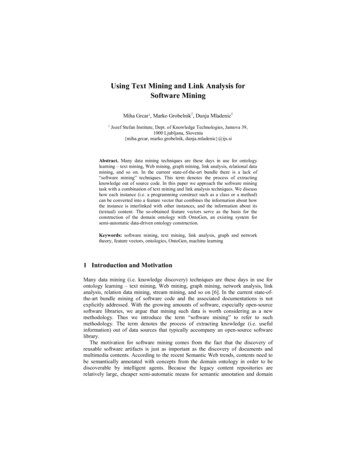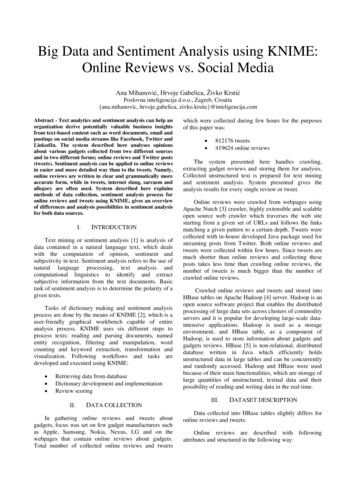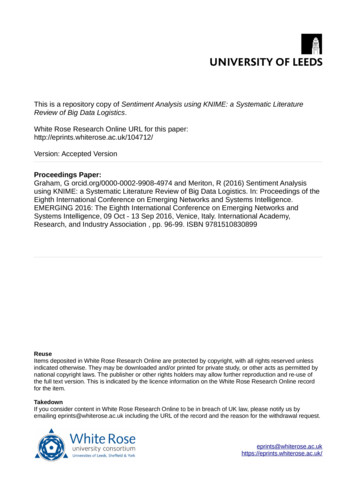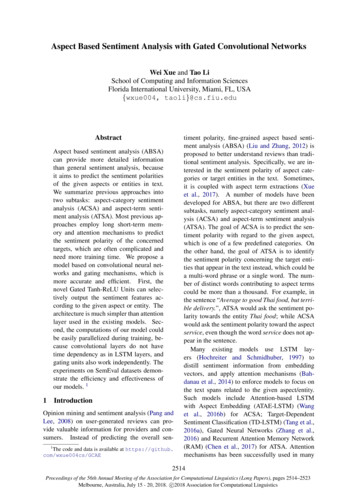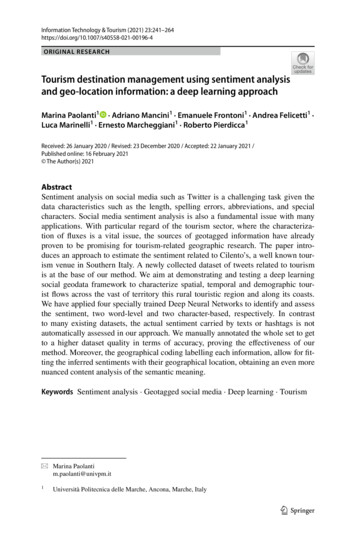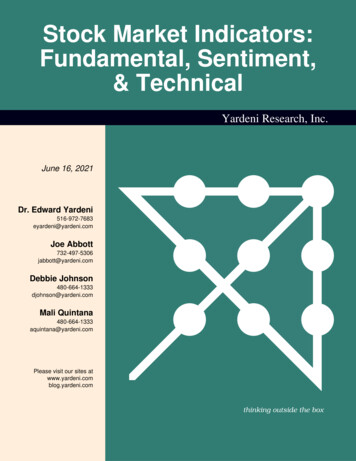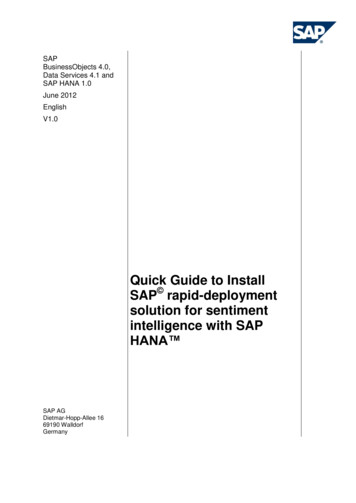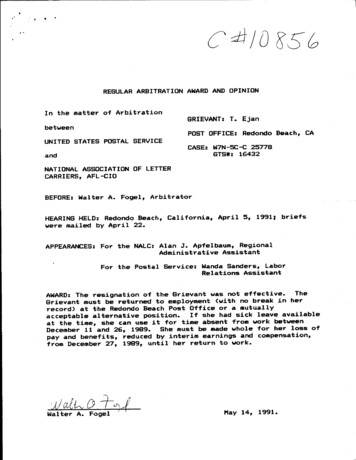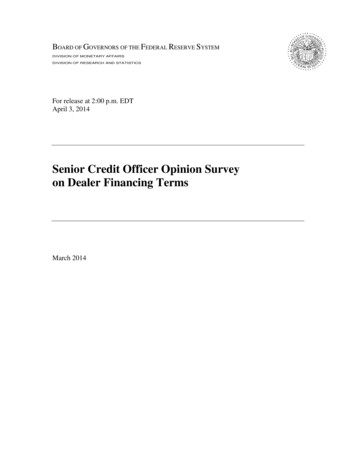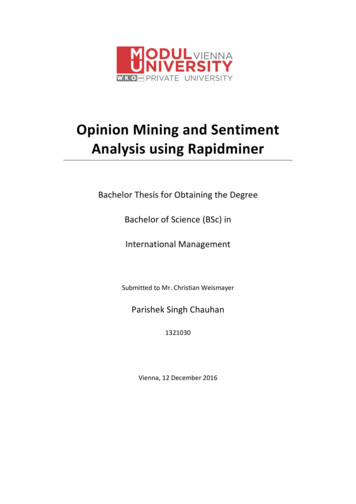
Transcription
Opinion Mining and SentimentAnalysis using RapidminerBachelor Thesis for Obtaining the DegreeBachelor of Science (BSc) inInternational ManagementSubmitted to Mr. Christian WeismayerParishek Singh Chauhan1321030Vienna, 12 December 2016
AffidavitI hereby affirm that this Bachelor’s Thesis represents my own written work and that Ihave used no sources and aids other than those indicated. All passages quoted frompublications or paraphrased from these sources are properly cited and attributed.The thesis was not submitted in the same or in a substantially similar version, noteven partially, to another examination board and was not published elsewhere.DateSignature2
AbstractIn the recent years, a vast amount of research has been conducted on the topic ofsentiment analysis and opinion mining. Businesses and organizations understand thepotential benefits of developing sentiment analysis and opinion mining systems. Inthis study, Rapidminer as a solution is proposed for analyzing online productreviews. A corpus of 200 reviews for the 25hours hotel in Vienna, Austria wascollected from the Tripadvisor website. Overall sentiment analysis as well as aspectbased sentiment analysis was performed on the reviews. The results were thencompared with the star rating provided by the reviewer using SPSS software tocheck the accuracy of the results. Finally, using the results from aspect-basedsentiment analysis, linear regression was used to predict the sentiment using themost frequently appearing aspects. The purpose of this study is to show that opensource software like Rapidminer can be used effectively to calculate the sentimentfrom online reviews as well as for aspect-based sentiment analysis. The results showthat Rapidminer is an effective tool. Aspect-based sentiment analysis can be used topredict sentiment and thereby business can use it to improve overall customersatisfaction by focusing on enhancing certain aspects of their products and services.3
Table of ContentsAffidavit2Abstract3List of Tables6List of Figures6List of Abbreviations61723Introduction1.1Introduction and Background71.2Objectives of the study81.3Structure of the study8Literature Review92.1How opinion was gathered in the pre-internet era92.2Online Reviews112.3What is Opinion Mining and Sentiment Analysis162.4Sentiment calculation and Aspect-based analysis192.5What Defines an Opinion202.6Different Types of Opinions212.7Different Levels of Opinion Mining222.7.1Document level opinion mining232.7.2Sentence level opinion mining242.7.3Aspect-based opinion mining252.8Opinion Spam272.9Sentiment Lexicon292.9.1What is it?292.9.2Problems with Sentiment Lexicon Analysis292.9.3Sentiment Lexicon generation30Tripadvisor, Rapidminer and 25hours hotel313.1Tripadvisor as a website313.2Rapidminer as a software334
3.3425hours hotel Vienna34Methodology354.1Hypothesis setup354.2Data collection and analysis365Results406Discussion and Conclusion437Limitations448Implications for future research449Bibliography455
List of Tables Table-1, Polarity confidence of the review text Table-2: Polarity confidence of the review title Table-3: Frequency of the aspectsList of Figures Figure-1: Star rating Figure-2: Traveller type Figure-3: Aspects and their occurrence in reviews Figure-4: Spearman’s correlation for star rating and sentiment Figure-5: Spearman’s correlation for sentiment of the review text and of thetitle text Figure-6: Regression analysisList of Abbreviations SPSS: Statistical Package for the Social SciencesAPI: Application Program InterfaceE-WOM: Electronic Word of Mouth6
1Introduction1.1 Introduction and BackgroundPeople all make decisions in their daily lives based on information that they gatherfrom different sources. In recent years, there has been exponential growth of theInternet. A significant number of people gain access to the Internet everyday. As perthe website (www.internetlivestats.com, 2016), about 40% of the population of theworld accesses the Internet on a daily basis. It is largely believed that this number isexpected to keep growing in the future. As the Internet becomes a normal inpeople’s daily lives, they are also more likely to leave a larger footprint on theInternet. The footprint in question here is the plethora of raw data that people addto the Internet every day. Every minute of Internet usage is equivalent to 640terabytes of data transferred (Burgess, 2013). A large chunk of this data is generatedby social media websites like Facebook, Twitter, Instagram, etc. The Internet hasbecome an essential part of people’s lives. People also use the Internet to expresstheir opinions towards certain things. These can range from the recent election, tothe latest movie or the latest smartphone to hit the market. These opinions containa treasure trove of data, which can be analyzed for meaningful insights into peoples’minds.Hence, it is no wonder that companies, organizations, etc. would be interested infinding out what people think about their products, campaigns and so on. This bringsus on to the topic of opinion mining and sentiment analysis. These two terms areinterchangeable and have the same meaning. It becomes clear that with the vastamounts of raw data available on the Internet, the significance of sentiment analysishas increased in the recent years. Customers are more likely to do online researchabout the products before they make their purchasing decisions. ‘In the modern eraof information and communication technologies, it has become quite common thatcustomers create their opinion not just by talking to friends or reading expertreviews in magazines but also reading reviews of other customers on the Internet’(Prichystal, 2016, p. 373). This online research mostly involves reading onlinereviews. This information is a potential treasure trove of information for businesseslooking to gain meaningful insights into how customers feel about their products.7
Hence, it becomes clear that there is a need to have a method of extractingmeaningful information from this data.1.2 Objectives of the studyThe objective of the study is to analyze online reviews, which are widely available onthe Internet. Most reviews available online contain the text of the review, theassociated star rating provided by the reviewer themselves and a small title for thereview. This study involves collecting reviews from an online source, analyzing thetext contained in the review and calculating the overall sentiment associated withthe text. As a final step aspect-based sentiment analysis is also performed on thereviews. Rapidminer software was used to conduct the analysis. The intention of thisstudy was to find out if such an analysis would generate meaningful results andshow that aspect-based sentiment analysis can help businesses to fine-tune theirofferings in order to increase customer satisfaction. This is done by comparing theoutput of the textual analysis against the already mentioned star rating provided bythe reviewer. The aspects are then compared against the star rating. The goal was tocheck if the mention of certain aspects could be used to predict the star ratingassociated with the review. Another goal of the study was to compare the sentimentin the review text provided by the reviewer against the calculated sentiment in thetitle of the review. The aim was to find out whether the title of the review alone canbe used to predict the sentiment of the entire review.1.3 Structure of the studyThe study involved various stages. In the first stage a corpus of reviews about the25hours hotel located in Vienna, Austria from the Tripadvisor website was collected.In the second stage, the reviews were analyzed using text-mining softwareRapidminer to calculate the sentiment associated with the text of the review and thetitle of the review. During this stage, aspect-based sentiment analysis on the text ofthe review was also performed. In the third stage, analysis on the gathered reviewswas performed using IBM SPSS Statistics software. A series of tests were performedon the data, which are listed as follows:a) Spearman’s correlation on sentiment associated with the text of the reviewand the star rating provided by the reviewer.8
b) Spearman’s correlation on sentiment associated with the text of the reviewand the title of the review.c) Linear regression is performed to find out if star rating can be predictedusing certain aspects mentioned in the text of the review.2 Literature Review2.1 How opinion was gathered in the pre-internet eraOpinion mining and sentiment analysis stem from the need to gather public opinion.In the pre-internet era, public opinion was gathered by conducting polls, surveys,etc. This process usually took longer and was an enduring task. Moreover, the costof conducting surveys and polls was also usually high. Another problem that existswith gathering public opinion using this method is that it when we talk aboutgathering the opinion of the public, the aim is to capture the opinion of the entirepopulation, however this is not entirely feasible in reality. In reality, a representativesample population is chosen which will reflects the opinion of the overall population.The problem that then arises through this method is that it is mostly impossible tohave a sample that can be used to fully represent the overall population. Methods ofgathering public opinion have been researched since the early 1900’s. However, onlyrecently starting from the year 2000 onwards other methods of gathering publicopinion have been used. Not only polls and surveys but also the so-called onlinechatter can be used to gather and measure public opinion. This method eliminatesthe need for choosing a representative sample, the sentiment of the population as awhole can be analyzed. Moreover, it does not involve manual data entry in any ofthe steps. It is not as expensive as the older methods as everything can be doneusing computers and from a single location. Another key feature of this method isthat the process of collecting individual’s opinions is easier in the sense that the allthe data that needs to be analyzed is already available to the researcher and they donot need to make any special effort in collecting the data. This greatly increases theefficiency and the speed of the overall process of gathering public opinion.Gathering public opinion has been of significance in many areas namely, politics,business, governance, scientific research, etc. Political parties can be considered in9
this regard as the ones who greatly need to gather and correctly measure publicopinion. A good example of this is the elections in the United States of Americawhere, political parties invest heavily in opinion polls, which help them choose theabsolute correct future strategy. It can be safely said that without having an ideaabout what the general public thinks about the political parties objectives, thepolitical party would have a significant disadvantage compared to the other wellinformed opponents. This could be seen clearly in the recent 2017 presidentialelections in the United States of America where the Republicans were able tocorrectly measure public opinion and their presidential candidate was able toconnect with the population on a greater level than the opponent. Measuring publicopinion with such accuracy was certainly not possible in the pre-internet era. Theadvent of opinion mining and sentiment analysis has changed the world of politicsand elections. Websites like Twitter and Facebook generate huge amounts of dataeach day, much of it is online chatter, which can also be analyzed. Political partiescan mine this data to find out which issues are of highest concern to the people andwhat is their opinion on such issues.Businesses are another group, which could benefit greatly from being able tocorrectly measure public opinion. However in this case, businesses are notconcerned with political issues but rather the performance of their products andservices and the opinions held by their customers about them. They could also use itto find out how their brand is perceived and the preferences of their customers.Moreover, they could also use it to do research on their competitors’ brand as wellas their offerings. In the pre-internet era gathering peoples’ opinion was not possibleon such large scale and the process was difficult and expensive. Market researchagencies were employed to conduct large scale and time-consuming research. Evenafter spending a significant portion of their capital on market research, businesscould not be sure of the results, as it’s difficult to accurately choose a sample that isfully representative of the population. With the growing popularity of the Internet,businesses can now use online chatter to gather public opinion. Research in the formof polls and surveys can also be conducted online. It is not required to choose arepresentative sample, information is already readily available and the entirepopulation can be used to gather public opinion. This has increased the accuracy aswell as reduced the cost and time required to measure public opinion. Moreover, in10
the pre-internet era, opinion could not be gathered in real-time whereas, now it ispossible to gather opinion in real time.Governments always have needed to be able to correctly measure public opinion.Policy-making is a particular field where governments could benefit from knowingthe opinion of the public, currently hardly any government is able to fully integratepublic opinion into the policy making process. Being able to correctly measure publicopinion allows governments to fully represent the interests of the people. However,currently this technology is not completely secure and is prone to manipulation byhackers. More research needs to be done in this area to make it completely secureand allow for the correct measurement of public opinion. The ability to fully gatherthe opinion of the public could be considered the holy grail of democracy. The aim ofany democracy is to be fully representative of its population. Such a system wouldrevolutionize how democracies function. The current system where citizens vote forsomeone to represent themselves and then such a group of such representativesform the government is an archaic system, which needs to be updated. Manyfunctions which democratic governments need to perform like law making andpolicy making usually take a long period of time. In a system where people coulddirectly represent themselves in the government would allow such processes tobecome faster and more efficient.The field of opinion mining and sentiment analysis is only in the very early stagesand researchers have barely even scraped the surface. Moreover, this area ofresearch has only emerged since the invention of the Internet and more specificallywith the increase in the popularity of social networking websites, micro-bloggingwebsites and online review websites. The future of this field of research is promisingand a huge amount of research still needs to be conducted to fully tap its potential.2.2 Online ReviewsA number of researchers have looked into the topic of opinion mining and sentimentanalysis. Levy, Duan & Boo in 2013 analyzed only 1-star reviews from 86Washington DC hotels to try to understand poor or negative reviews. They looked atthe most common complaint areas and found that the most common complaintswere related to billing, check-in, hotel appearance, Internet, restaurant, room11
service, safety and front-desk. They were also able to rank these issues based ontheir occurrence in the reviews. Furthermore they found out that hotels, whichresponded to negative reviews, were found to have a higher overall rating. Theirstudy suggests a need for an effective management plan for negative reviews, andappointing a person with strong writing abilities to respond to negative reviews.They further stressed on the need to incorporate a strong and efficient feedbacksystem, which will eventually help the hotel increase its overall rating.Electronic word of mouth or E-WOM as it is abbreviated is simply the concept ofword of mouth but in regards to the online world. It is interesting to look into how EWOM spreads and what kind of effect it has on customers’ travel choices. Filieri &McLeay in 2013 looked into how online reviews help in spreading electronic word ofmouth, and how travellers base their decision to stay in a hotel based on onlinereviews. They found that product ranking or the so-called star rating had the highestinfluence on travellers’ decision. This is due to many reasons, for example, it allowstravellers to reduce the time and effort required in their search for anaccommodation. Besides this, travellers also look at information factors such asquality, completeness and value-added information, which is not attainable throughregular marketing channels. However, they found that the accuracy or relevance ofthe information available in online reviews was not a major factor in influencingtravellers’ decisions. They propose that travellers should be considered as sort of comarketers in today’s world who influence the decision of other travellers throughthe feedback they provide in online reviews.Another interesting topic is to look into how eager people are to post online reviews.In this regard, a study conducted by Dellarocas, Gao & Narayan in 2010 looked atpeoples’ eagerness to post online reviews. They looked at two different categoriesof niche products as well as highly popular and reviewed products. It was found thatpeople are equally likely to post reviews for niche products as well as highly popularproducts. They did this by looking at reviews posted for movies, it was found thatinitially people are more likely to post reviews for newly released films, followed bya decline as the revenues of the movie increase, finally as the movie becomes evenmore popular the eagerness to post reviews increases further amongst the people.Their study suggested that companies should make the number of reviews already12
posted as a less prominent feature for niche products, which makes people morelikely to post a review.A key problem in recent years has been the issue of fake online reviews. Fakereviews are a major nuisance and a threat to the credibility of the online rating andreview websites. Moreover, it has become increasingly difficult to detect fakereviews and ratings due to the perpetrators becoming better at posting fake onlinereviews. In this regard, Yoo & Gretzel in 2009 looked at mechanisms to separatefake reviews from real ones. Fake reviews can be really harmful for a website,moreover they may lead to the customer making a wrong decision which in-turnleads to more dissatisfaction in the end. They found that it is extremely difficult todetect fake online reviews as the people who post them are increasingly becomingbetter at hiding such reviews by basing their structure on other real reviews. Theysuggest that more research be conducted to confirm their findings.A number of researchers have looked into the impact of online reviews on salesfigures. A study conducted by Hu, Liu, & Zhang in 2008 looked into the effect ofonline reviews on sales revenue. It is interesting to find out the empirical effects onhotel sales with respect to online reviews. They found positive correlation betweenproduct sales and online ratings, however the effect of high online ratings on salesdiminished over time. Moreover it was found that customers are likely to payattention not only to the review score but as well as the reviewer profile, whichimplies that how often the reviewer has reviewed a product online. Another keyfinding was that customers are more likely to be influenced by a review when thereexist few reviews for the product, however in case there already exist many reviewsfor a product, a new review, even if it contains new information is not likely to haveany effect on the customers perce
using certain aspects mentioned in the text of the review. 2 Literature Review 2.1 How opinion was gathered in the pre-internet era Opinion mining and sentiment analysis stem from the need to gather public opinion. In the pre-internet era, publi
